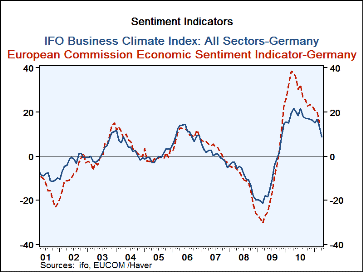 Global| Apr 21 2011
Global| Apr 21 2011IFO and EU Indices Show Unwind for Germany: Back to Normalcy?
Summary
The German IFO index showed a weaker climate reading in April. Both the topical IFO and the lagging EMU index for Germany are showing a damping down for the overall climate index (see chart). The Manufacturing index which is stronger [...]
 The German IFO index showed a weaker climate reading in April. Both the topical IFO and the lagging EMU index for Germany
are showing a damping down for the overall climate index (see chart). The Manufacturing index which is stronger in absolute
and relative terms than all the other sector indices also stepped down in April from its cycle peak in March. The Services
reading moved up above the MFG raw reading but the 91st percentile standing in its range in its range underscores that in reality
it is lagging. But with this month’s rise the services current index has reached its cycle peak even though its climate reading
peaked in February. Wholesaling climate also peaked in February. Construction, however, which remains negative, saw conditions
improve slightly in the month.
The German IFO index showed a weaker climate reading in April. Both the topical IFO and the lagging EMU index for Germany
are showing a damping down for the overall climate index (see chart). The Manufacturing index which is stronger in absolute
and relative terms than all the other sector indices also stepped down in April from its cycle peak in March. The Services
reading moved up above the MFG raw reading but the 91st percentile standing in its range in its range underscores that in reality
it is lagging. But with this month’s rise the services current index has reached its cycle peak even though its climate reading
peaked in February. Wholesaling climate also peaked in February. Construction, however, which remains negative, saw conditions
improve slightly in the month.
Overall current conditions are still improving in the month and are on their cycle high. But expectations are fading, having peaked in February.
The IFO indices still show strong readings across most sectors. The statistics for ‘percent of range’ tell the story of how unusually elevated these reading are. We know that this happens in the early stage of recovery, sectors get unsustainably strong after a period of weakness then they settle down. This pattern is normal. There is nothing in the damping down of the IFO indices at this points that should not be of concern. This is the normal progression after a recession in an economic recovery.
| Summary of IFO Sector Diffusion Readings: CLIMATE | ||||||||
|---|---|---|---|---|---|---|---|---|
| Climate | Current | Last Mo | Since Jan 1991* | |||||
| Apr-11 | Mar-11 | Avg | Median | Max | Min | Range | % Range | |
| All Sectors | 19.9 | 21.4 | -8.4 | -9.4 | 21.8 | -36.0 | 57.8 | 96.7% |
| MFG | 28.8 | 29.9 | -1.0 | 0.1 | 29.9 | -42.7 | 72.6 | 98.5% |
| Construction | -5.7 | -7.2 | -28.8 | -29.5 | -3.6 | -49.7 | 46.1 | 95.4% |
| Wholesale | 18.8 | 22.4 | -13.0 | -15.7 | 26.2 | -39.8 | 66.0 | 88.8% |
| Retail | 9.1 | 12.1 | -15.0 | -14.4 | 24.0 | -40.0 | 64.0 | 76.7% |
| Services | 28.9 | 28.0 | 13.5 | 16.8 | 33.0 | -14.5 | 47.5 | 91.4% |
| Current conditions:ll | 28.1 | 27.3 | -10.3 | -13.5 | 28.1 | -38.2 | 66.3 | 1.0 |
| Expectations:All | 12.0 | 15.6 | -3.9 | -3.0 | 18.3 | -45.1 | 63.4 | 0.9 |
| * June 2001 for Services | ||||||||
Robert Brusca
AuthorMore in Author Profile »Robert A. Brusca is Chief Economist of Fact and Opinion Economics, a consulting firm he founded in Manhattan. He has been an economist on Wall Street for over 25 years. He has visited central banking and large institutional clients in over 30 countries in his career as an economist. Mr. Brusca was a Divisional Research Chief at the Federal Reserve Bank of NY (Chief of the International Financial markets Division), a Fed Watcher at Irving Trust and Chief Economist at Nikko Securities International. He is widely quoted and appears in various media. Mr. Brusca holds an MA and Ph.D. in economics from Michigan State University and a BA in Economics from the University of Michigan. His research pursues his strong interests in non aligned policy economics as well as international economics. FAO Economics’ research targets investors to assist them in making better investment decisions in stocks, bonds and in a variety of international assets. The company does not manage money and has no conflicts in giving economic advice.






